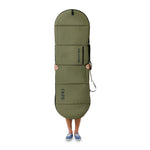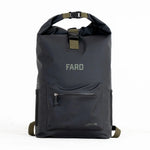Introduction
Surfing is more than just riding waves—it's built on respect, safety, and shared stoke. In this post, we dive deep into surf localism and surf etiquette, explaining what these concepts really mean, how they interact, and how to navigate them on your surf adventures. Whether you're a traveling surfer or a local regular, you'll find practical advice (and a few golden etiquette stories) that can help keep the lineup respectful and fun. We'll also show how FARO travel gear can support you along the way.
What Is Surf Localism—and Why Does It Matter?
Surf localism is the informal, often unspoken code enforced by local surfers to protect their home break. It’s built on respect, experience, and sometimes seniority. While critics may associate localism with exclusion, it can also serve as a safety mechanism—ensuring surfing order in crowded lineups.
But there’s a fine line between healthy localism, which enforces respect and safety, and unhealthy localism, which fosters aggression and intimidation. Understanding the difference is key to staying welcome in any lineup.
Surf Etiquette: The Rules of the Sea
Surf etiquette is the set of universal guidelines every surfer should follow, regardless of where they surf:
-
Right of way: The surfer closest to the wave peak has priority.
-
Don’t drop in: Never take someone else’s wave—that’s a major no-no.
-
Paddle smart: Avoid paddling through someone riding a wave; move wide.
-
Wait your turn: In a crowded lineup, respect turns rather than trying to dominate.
-
Mind the lineup dynamics: Don’t snake (paddle around or cut in front of) others—always show respect in the water.
These shared standards help avoid accidents, reduce tension, and ensure everyone has a great session.
Healthy vs. Unhealthy Localism
Unhealthy Localism
This form of localism crosses a line. It’s not about respect—it’s about intimidation. Signs include:
-
Aggressive yelling or hostile confrontations
-
Physically assertive behavior or exclusion
-
Skipping the etiquette protocols altogether
Example: A surfer dominates a mellow day by yelling at people to clear the lineup—even when they aren't technically in his way—souring the mood and violating the “give respect to get respect” mentality.
Healthy Localism
Conversely, healthy localism is rooted in community and safety:
-
Local regulars maintaining order in crowded lineups
-
Senior surfers helping newcomers integrate
-
Occasional verbal correction to dangerous behaviors (not intimidation)
In North County San Diego, Morgan recalls how a regular told an inexperienced paddleboarder that he was putting others at risk—not to scold him, but to keep everyone safe.
Morgan’s Personal Stories: Helpful Insights
First Time at a New Break
Morgan shares how, when arriving at a tense lineup, he opts to sit off-line and observe before jumping in. This gives him a chance to learn who’s in control of the peak—and respect the established order.
Burned at the Takeoff, Again
He’s felt the sting of being dropped in on when he’s not a local. With waves scarce and impatience high—common since the Covid surf boom—it’s clear etiquette and localism are more necessary than ever.
Anger at the Wrong Time
In a foggy Pacific Northwest morning, Morgan witnessed a surfer yell at people sitting down the line even though they weren’t actually encroaching. It was fear-based aggression, not etiquette—the exact opposite of how localism should function.
How Localism Supports Etiquette and Safety
Far from being about exclusion, healthy localism provides structure. It ensures that lineups function smoothly, especially when crowded.
With enough experience and respect, local regulars can calmly redirect behavior when someone is out of control—like the paddleboarder who repeatedly dropped in over others. Morgan noted how a blunt reminder kept everyone safe without escalating into conflict.
He also emphasizes the custom of newcomers sitting farther out until locals catch a few waves. It’s simple—observe, respect the line, and gradually earn your place.

Practical Tips: Navigating Localism as a Visiting Surfer
| Tip # | Guidance |
|---|---|
| 1. Observe before paddling in | Sit off the peak, watch the flow, and figure out the pecking order. |
| 2. Be aware of language and signs | A greeting or polite nod can go a long way. |
| 3. Avoid dropping in or snaking | If you accidentally do, apologize immediately. |
| 4. Respect locals’ priority level | Even if you surf better, respect the hierarchy until you’re part of the community. |
| 5. Stand up (politely) if someone is unsafe | If a less experienced surfer is endangering others, address it quietly and respectfully. |
| 6. Stay humble and flexible | Every spot has its own culture—adjust accordingly. |
How FARO Gear Makes Local and Travel Surfing Easier
When you’re traveling or switching break zones, your gear should help—not hinder—your surf experience. FARO offers gear designed to be durable, protective, and travel-friendly:
-
FARO travel surfboard bags: Reliable protection from checking airlines, sand, and dings.
-
Canvas surfboard protectors: Lightweight and compact—ideal for quick trips or flights.
Whether you’re carrying a longboard or funboard, we’ve got the perfect fit to keep your gear safe—meaning fewer distractions and more focus on surfing.
Ready to step into that new lineup with confidence?
Get your FARO travel surfboard bag today and travel without worry—whether you’re surfing your local break or chasing swells across the globe:
Conclusion
The interplay between surf localism and surf etiquette is both delicate and essential. When practiced with respect, localism helps the lineup run smoothly, safely, and fairly—especially in crowded conditions. On the other hand, unhealthy localism breeds tension and exclusion. By combining relaxed observation, respectful communication, and awareness of local dynamics, any surfer—from beginner to seasoned traveler—can blend into new spots respectfully.
At the heart of surfing lies community. FARO gear supports that community by keeping your board safe—so you can focus on riding waves and building connections, wherever you go.
Frequently Asked Questions
Apologize immediately and avoid making the same mistake again.
Look for tight-knit groups controlling the peak and observe before paddling in.
No, it varies—some breaks are friendly, others have strict unspoken rules.
Stay humble, observe lineup dynamics, and wait your turn patiently.
A polite nod or friendly greeting can go a long way.





